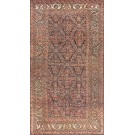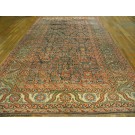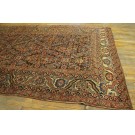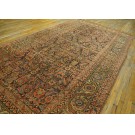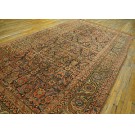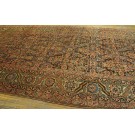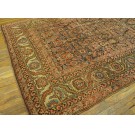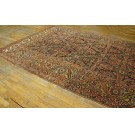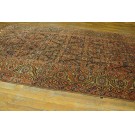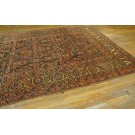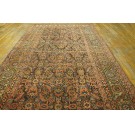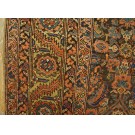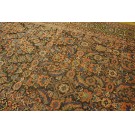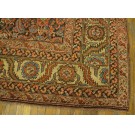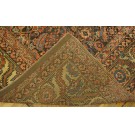19th Century N.W. Persian Bakshaiesh Carpet
Antique Bakhshaiesh Persian
Heriz – Bakhshaish Type
Azerbaijan Province, NW Persia
7’8” X 14’8”
Circa 1880s
“Heriz” is a rather generic name applicable to rugs and carpets from the general area around the rustic town of Heriz and includes, as here, “Bakhshaish”, “Serapi”, “Goravan”, Bilverdi , Ahar, and various other grades, types, periods and trade appellations. This wool foundation, symmetric (Turkish) knotted long carpet from the pre-export 1860 to 1880 period shows a corroded chocolate brown field with an allover Herati design. When viewed from a distance, there is a tall, lozenge lattice over-pattern. Often the field will be dark blue with an identical pattern.
The beige main border displays the ever-popular bracketed rosette and double bent leaf design with an attempt to symmetries the top and bottom strip borders. The side borders, of distinctly darker beige, are neatly fitted in. There is no attempt at rational corner turns. This is a usual Heriz practice. The inner minors employ tilted small fan palmettes.
The secondary colors include: light-medium blue, teal, straw, sand and salmon. All colors are of natural origin.
The elongated format is strictly Persian. The Western 8’ by 12’ dimensions were imposed as export demand increased after 1870. This carpet may have been part of a four-part room setting, with two parallel runners and a crosspiece at one end. Or it may have worked along on the floor of some local buyer.
This carpet is clearly a village production with the design not exactly centered. The carpet was woven in a household setting, not in a large factory with the weavers working from memory. No cartoons or diagrams were employed. The Herati pattern was so intuitive to weavers all across and beyond Persia, that they could execute it in their sleep. It was [popular in the 19th century and did not require a designer to create a medallion (and corners), thus keeping costs down and expediting the weaving process. For this carpet, a medallion would be no improvement.
The period of these Bakhshaish piece pretty much ended in the 1880’s and later Bakhshaish-manner carpets are much more squarish. This is a fine example of a type that came into and out of fashion and has left few, or no, survivors in Persia in their original sites.
The condition is generally good, with some appropriate corrosion to the dark brown and with the other areas still high and nearly shaggy. For a carpet nearly a century and a half old, the condition is exceptional.
Heriz – Bakhshaish Type
Azerbaijan Province, NW Persia
7’8” X 14’8”
Circa 1880s
“Heriz” is a rather generic name applicable to rugs and carpets from the general area around the rustic town of Heriz and includes, as here, “Bakhshaish”, “Serapi”, “Goravan”, Bilverdi , Ahar, and various other grades, types, periods and trade appellations. This wool foundation, symmetric (Turkish) knotted long carpet from the pre-export 1860 to 1880 period shows a corroded chocolate brown field with an allover Herati design. When viewed from a distance, there is a tall, lozenge lattice over-pattern. Often the field will be dark blue with an identical pattern.
The beige main border displays the ever-popular bracketed rosette and double bent leaf design with an attempt to symmetries the top and bottom strip borders. The side borders, of distinctly darker beige, are neatly fitted in. There is no attempt at rational corner turns. This is a usual Heriz practice. The inner minors employ tilted small fan palmettes.
The secondary colors include: light-medium blue, teal, straw, sand and salmon. All colors are of natural origin.
The elongated format is strictly Persian. The Western 8’ by 12’ dimensions were imposed as export demand increased after 1870. This carpet may have been part of a four-part room setting, with two parallel runners and a crosspiece at one end. Or it may have worked along on the floor of some local buyer.
This carpet is clearly a village production with the design not exactly centered. The carpet was woven in a household setting, not in a large factory with the weavers working from memory. No cartoons or diagrams were employed. The Herati pattern was so intuitive to weavers all across and beyond Persia, that they could execute it in their sleep. It was [popular in the 19th century and did not require a designer to create a medallion (and corners), thus keeping costs down and expediting the weaving process. For this carpet, a medallion would be no improvement.
The period of these Bakhshaish piece pretty much ended in the 1880’s and later Bakhshaish-manner carpets are much more squarish. This is a fine example of a type that came into and out of fashion and has left few, or no, survivors in Persia in their original sites.
The condition is generally good, with some appropriate corrosion to the dark brown and with the other areas still high and nearly shaggy. For a carpet nearly a century and a half old, the condition is exceptional.
| Stock ID: | #40-804 |
| General Rug Type: | Persian Informal |
| Specific Rug Type: | Bakshaiesh |
| Circa: | 1880 |
| Ground Color: | Chocolate Brown |
| Border Color: | Straw |
| Origin: | Persia |
| Material: | Wool |
| Weave: | Pile - Knotted |
| Shape: | Rectangle |
| Width: | 7' 8" ( 234 cm ) |
| Length: | 14' 8" ( 447 cm ) |
DescriptionBakshaieshPrimarily a trade term applied to a wide variety of weaves and design styles of Heriz area carpets from about 1870 to 1895. there is no consistent theme, but Caucasian tonalities of red, light and medium blue, ivory and green prevail, wool often occurs in the foundation. Although the town of Bakshaiesh appears on rug maps, it is unclear if all the carpets in question were woven there. Strong open medallion designs or ingenious overall patterns are frequent. Bakshaiesh carpets, evn those in need of restoration, can command healthy prices. Sizes are primarily in carpets up to 12 x 20, but a few scatters were woven. | |
| Tearsheet Download | |

